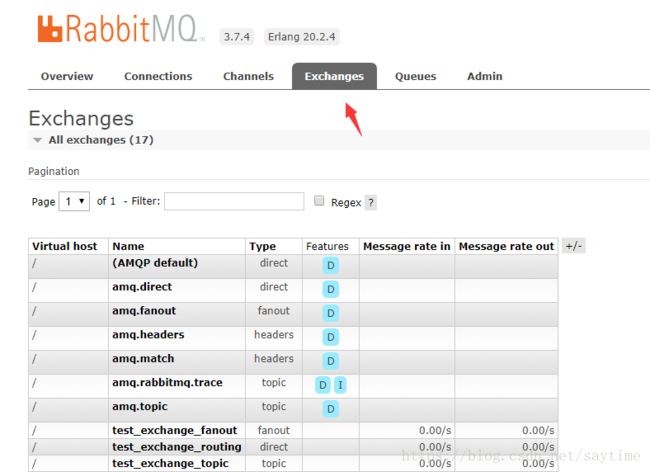RabbitMQ(五):路由模式
一、路由模式
官方内容参考:http://www.rabbitmq.com/tutorials/tutorial-four-java.html
跟订阅模式类似,只不过在订阅模式的基础上加上了类型,订阅模式是分发到所有绑定到交换机的队列,路由模式只分发到绑定在交换机上面指定路由键的队列。
![]()
二、direct交换机
生产者申明一个direct类型交换机,然后发送消息到这个交换机指定路由键。
消费者指定消费这个交换机的这个路由键,即可接收到消息,其他消费者收不到。
上章节中的生产者:
channel.basicPublish(EXCHANGE_NAME, "", null, message.getBytes());第二个参数就是路由键
消费者:
channel.queueBind(QUEUE_NAME, EXCHANGE_NAME, "");第三个参数就是路由键
三、代码演示
同样的,只是交换机类型改为direct,加了个路由键而已。
这里按图演示两个,即表示一个日志事件,根据日志类型进行处理。
连接RabbitMQ工具类
package cn.saytime.rabbitmq.util;
import com.rabbitmq.client.Connection;
import com.rabbitmq.client.ConnectionFactory;
import java.io.IOException;
import java.util.concurrent.TimeoutException;
/**
* RabbitMQ连接工具类
*/
public class ConnectionUtil {
private static final String host = "192.168.239.128";
private static final int port = 5672;
/**
* 获取RabbitMQ Connection连接
* @return
* @throws IOException
* @throws TimeoutException
*/
public static Connection getConnection() throws IOException, TimeoutException {
ConnectionFactory connectionFactory = new ConnectionFactory();
connectionFactory.setHost(host);
connectionFactory.setPort(port);
// connectionFactory.setUsername("test");
// connectionFactory.setPassword("123456");
// connectionFactory.setVirtualHost("/vhost_test");
return connectionFactory.newConnection();
}
}
如上所示,如果配置有用户名密码以及vhost,则配置即可。
生产者
package cn.saytime.rabbitmq.routing;
import cn.saytime.rabbitmq.util.ConnectionUtil;
import com.rabbitmq.client.BuiltinExchangeType;
import com.rabbitmq.client.Channel;
import com.rabbitmq.client.Connection;
import java.io.IOException;
import java.util.concurrent.TimeoutException;
/**
* 生产者
*/
public class Send {
private static final String EXCHANGE_NAME = "test_exchange_fanout";
public static void main(String[] args) throws IOException, TimeoutException {
// 获取连接
Connection connection = ConnectionUtil.getConnection();
// 从连接开一个通道
Channel channel = connection.createChannel();
// 声明一个direct路由交换机
channel.exchangeDeclare(EXCHANGE_NAME, BuiltinExchangeType.DIRECT);
// 发送info路由键消息
String infoMessage = "hello, info";
channel.basicPublish(EXCHANGE_NAME, "info", null, infoMessage.getBytes());
System.out.println(" [x] Sent routing info message : '" + infoMessage + "'");
// 发送error路由键消息
String errorMessage = "hello, error";
channel.basicPublish(EXCHANGE_NAME, "error", null, errorMessage.getBytes());
System.out.println(" [x] Sent routing error message : '" + errorMessage + "'");
channel.close();
connection.close();
}
}
info日志消费者
package cn.saytime.rabbitmq.routing;
import cn.saytime.rabbitmq.util.ConnectionUtil;
import com.rabbitmq.client.*;
import java.io.IOException;
import java.util.concurrent.TimeoutException;
/**
* info日志消费者
*/
public class Recv {
// info日志队列
private static final String QUEUE_NAME = "test_queue_routing_info";
private static final String EXCHANGE_NAME = "test_exchange_routing";
public static void main(String[] args) throws IOException, TimeoutException {
// 获取连接
Connection connection = ConnectionUtil.getConnection();
// 打开通道
Channel channel = connection.createChannel();
// 申明要消费的队列
channel.queueDeclare(QUEUE_NAME, false, false, false, null);
// 绑定队列到交换机
channel.queueBind(QUEUE_NAME, EXCHANGE_NAME, "info");
// 这样RabbitMQ就会使得每个Consumer在同一个时间点最多处理一个Message。换句话说,在接收到该Consumer的ack前,他它不会将新的Message分发给它。
channel.basicQos(1);
// 创建一个回调的消费者处理类
Consumer consumer = new DefaultConsumer(channel) {
@Override
public void handleDelivery(String consumerTag, Envelope envelope, AMQP.BasicProperties properties, byte[] body) throws IOException {
// 接收到的消息
String message = new String(body);
System.out.println(" [1] Received '" + message + "'");
try {
Thread.sleep(1000);
} catch (InterruptedException e) {
e.printStackTrace();
} finally {
System.out.println(" [1] done ");
channel.basicAck(envelope.getDeliveryTag(), false);
}
}
};
// 消费消息
channel.basicConsume(QUEUE_NAME, false, consumer);
}
}
error日志消费者
package cn.saytime.rabbitmq.routing;
import cn.saytime.rabbitmq.util.ConnectionUtil;
import com.rabbitmq.client.*;
import java.io.IOException;
import java.util.concurrent.TimeoutException;
/**
* error日志消费者
*/
public class Recv2 {
// error日志队列
private static final String QUEUE_NAME = "test_queue_routing_error";
private static final String EXCHANGE_NAME = "test_exchange_routing";
public static void main(String[] args) throws IOException, TimeoutException {
// 获取连接
Connection connection = ConnectionUtil.getConnection();
// 打开通道
Channel channel = connection.createChannel();
// 申明要消费的队列
channel.queueDeclare(QUEUE_NAME, false, false, false, null);
// 绑定队列到交换机
channel.queueBind(QUEUE_NAME, EXCHANGE_NAME, "error");
// 这样RabbitMQ就会使得每个Consumer在同一个时间点最多处理一个Message。换句话说,在接收到该Consumer的ack前,他它不会将新的Message分发给它。
channel.basicQos(1);
// 创建一个回调的消费者处理类
Consumer consumer = new DefaultConsumer(channel) {
@Override
public void handleDelivery(String consumerTag, Envelope envelope, AMQP.BasicProperties properties, byte[] body) throws IOException {
// 接收到的消息
String message = new String(body);
System.out.println(" [2] Received '" + message + "'");
try {
Thread.sleep(1000);
} catch (InterruptedException e) {
e.printStackTrace();
} finally {
System.out.println(" [2] done ");
channel.basicAck(envelope.getDeliveryTag(), false);
}
}
};
// 消费消息
channel.basicConsume(QUEUE_NAME, false, consumer);
}
}
四、测试结果
提前在管理控制台创建一个direct交换机,或者先执行一次生产者(执行时会判断交换机是否存在,不存在则创建交换机),这样保证交换机存在,不然直接启动消费者会提示交换机不存在。
注意点
如果在没有队列绑定在交换机上面时,往交换机发送消息会丢失,之后绑定在交换机上面的队列接收不到之前的消息,也就是先执行第一次发送,创建了交换机,但是还没有队列绑定在交换机上面,如果这次发送的消息就会丢失。
然后启动两个消费者,再执行生产者。
Send
[x] Sent routing info message : 'hello, info'
[x] Sent routing error message : 'hello, error'Recv
[1] Received 'hello, info'
[1] done Recv2
[2] Received 'hello, error'
[2] done 我们可以看到生产者往info路由键发送消息时,只有执行消费info路由键的消费者才能接收到消息,error路由键同样。
五、多绑定情况
1. 同一个消费者绑定队列多个路由键
channel.queueBind(QUEUE_NAME, EXCHANGE_NAME, "info");
channel.queueBind(QUEUE_NAME, EXCHANGE_NAME, "error");
channel.queueBind(QUEUE_NAME, EXCHANGE_NAME, "warn");如果一个消费者绑定了这三个路由键,那么当生产者发送其中一个路由键消息时,该消费者都能接收到消息。
2. 多个消费者绑定相同路由键
即消费者1绑定info,消费者2 绑定info, error
那么生产者发送info路由键消息时,消费者1, 2都能接收到消息,发送error路由键消息时,只有消费者2能接收到消息。
